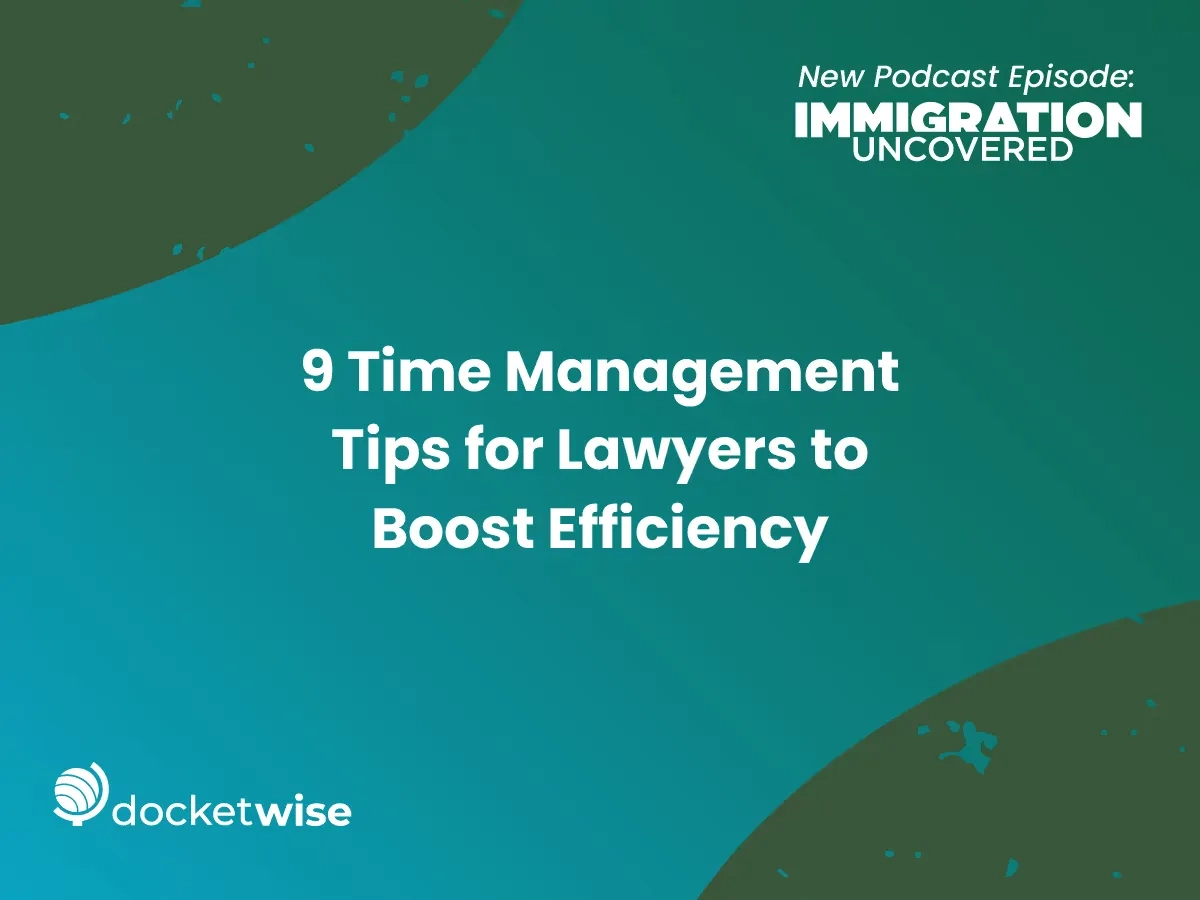Time is one of the most valuable resources for lawyers, especially in a high-demand field like immigration law. Without proper time management, even the most skilled legal professionals can struggle to keep up with caseloads, client communication, and the unexpected issues that arise daily.
In this episode of the Immigration Uncovered podcast, James Pittman, Docketwise’s Chief Product Architect, sat down with Nadine Heitz, an immigration lawyer and owner of Heitz Immigration Law, to discuss strategies for maximizing time management in a law firm. In their conversation, Heitz shares insights that are highly relevant to today’s legal professionals, covering key areas such as minimizing time-wasters and improving lawyer work schedules to better manage caseloads. Let’s dive in.
Common Time-Wasters for Lawyers
In the interview, Heitz and Pittman highlight several common time-wasters for lawyers, such as inefficient document collection and frequent client communication interruptions. These issues can severely impact a lawyer’s work schedule, leading to unnecessary stress and delays in important tasks.
Task Prioritization Challenges
Prioritizing tasks is one of the most essential time management skills for lawyers. With multiple cases, deadlines, and client demands to juggle, it’s easy for tasks to pile up and become overwhelming. Critical tasks can fall through the cracks without defining clear priorities and effectively communicating them across your team.
Document Collection Bottlenecks
It’s no surprise that paperwork is an integral part of practicing immigration law. With countless forms, supporting documents, and certifications needed for each case, document collection often becomes a significant time drain. Waiting for clients to gather and submit documents is one of the most common bottlenecks in any immigration case. Whether the documents are tax returns, identification, or proof of residency, even minor delays in document submission can halt a case's progress and push timelines further out.
Heitz points out that without a streamlined process for document collection, cases can easily stall. Clients might forget to submit key paperwork, or they may submit incomplete sets, requiring follow-ups and causing further delays and frustration for both the attorney and the client.
Excessive Back-and-Forth Communication
One of the most frequent drains on lawyer time is excessive back-and-forth communication. It’s all too common to spend hours caught in a cycle of emails and phone tag with clients, chasing down responses or trying to schedule updates. Not only does this waste valuable time, but it also interrupts the flow of more essential tasks that require the attorney’s focus. Managing these communications manually can become overwhelming, especially as your caseload grows.
With all of the time-consuming tasks lawyers deal with daily, implementing effective time management strategies is vital to running a successful immigration law firm. In the podcast, Heitz shares her firsthand experience with these tactics and provides several time management tips to ensure lawyers use their time wisely and avoid these time-wasting pitfalls.
Lawyer Time Management Best Practices
1. Automate Case Updates
Keeping clients in the loop with automated case status updates is a highly effective way to reduce busy work and handle one of a legal practice’s most repetitive yet essential tasks. Clients want regular updates on their cases, but manually providing these updates can be a time-consuming burden. Setting up automated notifications empowers law firms to keep clients current on critical milestones—such as document submissions, court dates, or feedback from government agencies—without getting bogged down in unneeded back-and-forth communication.
“The client experience is what generates client satisfaction, and that’s what gets you referrals and repeat business,” shares Pittman.
Additionally, automated systems create a trackable record of all client communications, providing transparency and preventing misunderstandings about the case’s status.
“We have an automated system that we use for document collection,” Heitz notes. “The client is constantly reminded of what they need to provide.” The same principle applies to case updates—automating these communications ensures that clients are kept in the loop while minimizing unnecessary disruptions to the workflow.
2. Minimize Email and Phone Tag with Automated Communication
Whether following up on missing documents, clarifying case details, or answering routine status inquiries, back-and-forth communication from overwhelming your day, Heitz recommends adopting automation tools that streamline client communication and reduce time spent exchanging emails and leaving voicemails.
“We waste a lot of time just on emails back and forth and phone calls,” says Heitz, adding that it’s preferable to “have a tool that automates this and reminds your client.”
Tools that automate client communications can help lawyers get hours of their time back. These systems can send regular reminders about deadlines, outstanding documents, and case progress, ensuring that clients stay informed without requiring additional manual communication. Clients are gently but consistently reminded to take action, keeping the case moving forward and allowing lawyers to focus on higher-value legal work.
3. Define Criteria for Urgent Scenarios
In a law firm, it’s easy to feel like every issue is urgent. However, lawyers can find themselves constantly interrupted without clear guidelines on what constitutes an emergency. This leads to distractions, which disrupt deep work and strategic thinking, preventing attorneys from focusing on long-term goals.
Heitz encourages firms to communicate clearly about urgency to filter out non-essential interruptions and ensure that only truly pressing issues demand immediate attention.
This approach allows for uninterrupted focus on higher-priority legal work, increasing both personal productivity and overall law firm efficiency.
4. Plan for Scalability Early
As your law firm grows, so do the complexities of managing staff, clients, and cases. Planning for scalability early allows you to establish policies, procedures, and workflows that will adapt to your firm’s growth. This includes systems for task delegation, case management, and communication. Establishing these scalable frameworks from the outset will make it easier to handle an increasing volume of cases and onboard new team members without disrupting operations.
By having solid systems in place from the start, your firm can expand smoothly and efficiently without the need for major process overhauls as your workload continues to grow. Ultimately, this will help you reduce stress and ensure consistency in delivering high-quality legal services.
5. Train Your Team on Efficiency
Effective time management for lawyers heavily relies on how well your team understands and utilizes the tools at their disposal. Simply having technology in place isn’t enough—your team must be adequately trained to use it effectively. Providing ongoing training on the latest tools and systems ensures that everyone is equipped to handle tasks efficiently, reducing errors and streamlining workflows. When your team is comfortable with the technology, they can perform their duties faster and with greater precision, contributing to overall law firm productivity.
Fostering a culture that values the use of technology to improve efficiency is essential.
Encourage your team to embrace new tools and workflows while also educating them on how these innovations can make their work easier and more effective. Ensure that your team doesn’t revert to old, time-wasting habits, but instead continues to optimize their performance through the use of technology.
6. Block Time for Specific Tasks
Heitz advocates for time-blocking as a powerful strategy to help lawyers manage their workloads more effectively and ensure uninterrupted focus. By allocating specific blocks of time on your calendar for different tasks—whether it’s client meetings, administrative work, case preparation, or personal commitments—you can create a structured schedule that ensures you stay on top of your priorities.
Nadine explains,
Sticking to a structured schedule can help you better manage your workload, reduce stress, and ensure that essential tasks receive the attention they deserve.
7. Plan Personal Time First
Planning personal commitments, such as vacations and family events, at the start of the year can make it easier to maintain a healthy work-life balance. Prioritizing these important moments early prevents work from taking over, ensuring that personal time doesn’t get lost in the shuffle of a busy schedule. It’s easy for critical personal milestones to be overshadowed by professional responsibilities, but when you block off time for them first, you can create a more balanced and fulfilling year.
“Map out your goals and be realistic in what you can accomplish in a year,” Heitz advises. “Put in the personal things first, like vacations and family commitments.”
This proactive approach helps lawyers stay productive while prioritizing their personal well-being and avoiding burnout.
8. Use Task Management Systems for Team Communication
Constant emails and interruptions can disrupt workflow and hinder productivity, especially in a busy law firm. Instead of relying on emails or impromptu conversations, Heitz recommends using a task management system for internal communication. These systems allow team members to assign tasks, ask questions, and track progress without interrupting one another’s focus.
rather than having to dig through lengthy emails, Heitz explains.
Task management systems also promote accountability and transparency within the team. Each task is clearly assigned to a responsible party, and any updates or questions can be reviewed in one central location. Consolidating all communications and tasks in one place enables team members to easily stay organized, follow up on tasks efficiently, and ensure that nothing gets overlooked.
9. Implement a Comprehensive Case Management System
A comprehensive case management system is essential for improving law firm efficiency and ensuring that tasks are organized and completed on time. Such systems allow for task prioritization, automated status updates, document management, and seamless communication between team members, reducing the risk of errors or missed deadlines.
Additionally, a robust case management system helps streamline workflows, such as document collection and client updates, into one platform. Implementing a comprehensive system not only enhances law firm efficiency but also saves time, allowing lawyers to focus on high-priority tasks and improving the overall client experience.
Manage Time Effectively with Docketwise
Docketwise is a comprehensive case management tool that improves law firm efficiency by automating many of the time-consuming tasks lawyers face daily. Specifically designed for immigration lawyers, Docketwise helps streamline task prioritization, document collection, and case updates, allowing attorneys to optimize their time management. Schedule a custom demo today to learn how Docketwise can help your firm get the most out of every minute.
Unlock Your Success as an Immigration Lawyer.
Download Now
About the author

Michael MielloContent Writer
